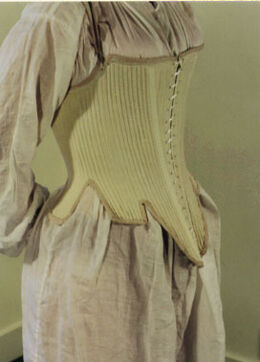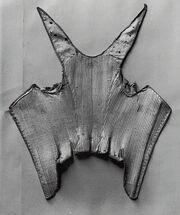
A late Elizabethan corset boned with broomstraw.
Corsets in the 16th century were light, flexible garments intended to support the torso and provide shape to, as well as distribute the weight of, heavy dresses that were fashionable at the time.
History[]
Prior to the 1500s, most clothing was tailored to fit the body. Any adjustment to the silhouette was made by a kirtle worn underneath dresses and other garments such as "breast bags" or underwear like the Lenberg bras . It's likely that the corset began as a kirtle with the bodice stiffened with buckram, and then perhaps reeds or bentgrass. However, when the decorative kirtle skirt became a separate item sometime in the 1530s, the upper half was probably retained as well and became the pair of bodies (so called because it was two halves laced together and only functioned as a pair). It's also possible that the corset evolved from the vasquina, a Spanish under-bodice that tied to the farthingale.

This pair of bodies, buried with Pfalzgrafin Dorothea Sabine von Neuberg in 1598, is the oldest surviving corset.
Either way, the flat conical torso silhouette popular throughout Europe in this period was achieved with stiffened bodice linings in various forms: a pair of bodies from Spain to England; and linen pads stiffened with paste between the lining and outer fabrics of gown bodices in Italy through at least the 1540s.

The Effigy Corset, discovered on the statue of Elizabeth I when the garments were removed for cleaning in 1995. Janet Arnold dated it to 1603.
The oldest extant pair of bodies dates from 1598 in Germany, and belonged to Pfalzgrafin Dorothea Sabine von Neuberg. It does not have lower tabs, but instead is lined with eyelets along the bottom that would have been used to lace the garment to a petticoat or farthingale. Its method of construction is theorized to be rather older than the burial date. The second oldest existing stays are those dressing the replica of Queen Elizabeth I at Madam Tussaud's Wax Museum, the Effigy Corset, dated to roughly 1603 and possibly earlier.
Terminology[]
Corsets of this era are most often referred to in historical texts as bodies, especially in the first half of the century.
Earliest sources call it a "payre of bodies", "peire of bodies", or other spelling variant. This term ha
s caused some comfusion and ambiguity amongst fashion historians because bodices of gowns were also called "pair of bodies".
In the latter half of the 1500s, it was called a French bodie, based on their popularity in France. In French they were known as corps pique, or "quilted body".
Construction[]
While there are not many depictions of corsets or any other undergarments from this era, those aspects of the garments that cannot be discerned from the surviving examples can be inferred from the outerwear.
Since at least 1530, the fashionable silhouette revolved around a conical torso with a flat front. At first, necklines were wide and square and started very high, with the bust flattened instead of raised, but as fashions evolved they gradually fell during the Tudor era and rose again with Elizabeth I's reign. This indicates the height of the top edge of the corsets which were worn underneath the gowns.
Armholes were quite far back on the torso, supporting a very rigid posture by today's standards. Stiff, upright posture was considered a mark of good breeding.
Straps were wide and triangular, and most often tied at the front points, though some tied behind as well.
Most corsets laced in the back, like the surviving German example. This
allowed the front to be stiffened by a busk, which aided in the creation of the appropriate silhouette. Busks were wide pieces of ivory, horn, bone, or wood that slipped into a pocket in the front of the garment. A busk-lace was sometimes used to prevent the busk from shifting.
Some corsets, such as indicated by the Effigy Corset, laced up the front instead. In such instances, there was no busk and instead narrower strips of bone or other boning were used on either side of the front opening. A few corsets may also have laced both in front and in back.
Most corsets extended past the waist in the center front in a roughly triangular shape; this shape eventually evolved into the stomacher that became popular in the 17th century. It was very common for bodies to have tabs along the lower edge, boned or unboned. These may have functioned by shaping outer garments or as a convenient way to attach a petticoat or farthingale.
Boning was most often done with lightweight material such as bentgrass, broomstraw, or other reeds. Corsets were fully boned in many narrow channels with no space in between.
Many corsets consisted of two or three or more layers of fabric.
See also[]
To Stay or Not To Stay - A discussion about whether stays or pairs of bodies were worn in Southern Italy during the Renaissance.
History of corsets